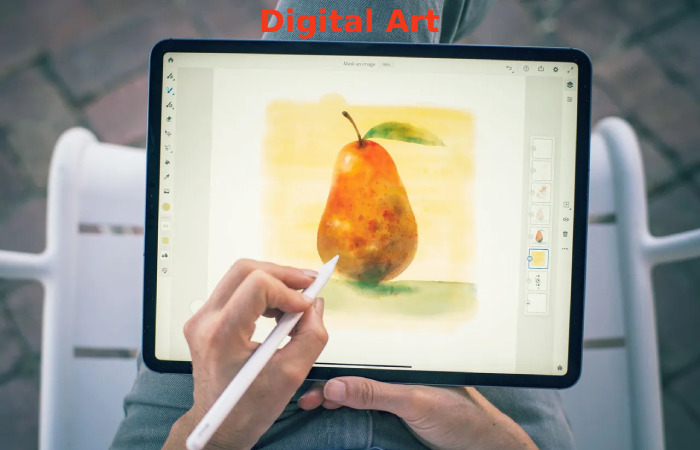Digital Art Write For Us

Digital art write for us – Digital art is a work made with or presented in digital technology. This includes images made entirely on the computer or hand-drawn photos scanned into a computer and finished using software such as Adobe Illustrator. Digital art can also include animations and renderings of 3D virtual sculptures and projects combining various technologies. In addition, some digital arts involve the manipulation of video images. If you are willing to send your article on Digital Art for the Technologywebdesign site, please email us at contact@technologywebdesign.com.
The word “digital art” was initially used in the 1980s in connection with one of the first computer painting programs. (That was long before they were called apps, of course!) It’s a method of creating art that lends itself to a multimedia format as it can be viewed in many ways, including television. And on the Internet, on computers, and several social media platforms. In short, digital art is a fusion between art and technology. And also, it allows for many new ways of making art.
The Beginnings of Digital Art
Digital art really couldn’t exist without computers. These machines that are so familiar to us today originated in the 1940s, when the first real computer, the Electronic Numerical Integrator and Computer, or ENIAC, was created for military purposes. And also, artists began to explore the possibilities of art from computers and related technologies in the late 1950s and early 1960s.
The first experiments with computer art took place around 1965. German artist Frieder Nake (1938 – present), also a mathematician, created a computer algorithm that allowed the machine to draw a series of shapes to create works of art. An algorithm, by the way, is a program list of instructions that tell a computer what to do. And also, the resulting computer-generated drawings were among the first examples of art made on a computer.
One of the first genuinely digital works of art was created in 1967 by Americans Kenneth Knowlton (1931 – present) and Leon Harmon (1922 – 1982). They took a photograph of a naked woman and turned it into an image of computer pixels, titled Computer Nude (Studies in Perception I). And also, a pixel is a tiny element of an idea; when many pixels are combined, they can create a larger and more complete image. This nude was one of the first digital artworks.
Growth of Digital Art
By the late 1960s, several museums held exhibitions exploring art using computers. Around the same time, various artists began to explore digital technology in multimedia art, using computers, television, video, and other belongings.
In 1969, artist Allan Ka prow (1927 – 2006), recognized for art proceedings called happenings, in which art was a series of activities or actions with audience participation and elements of chance, created a work titled Hello in collaboration with a Boston Television Station.
Centred in various locations around the city, it used television cameras and audio systems to allow people in different areas to talk to each other. But Ka prow, from the station’s main control center, toggled sites on and off, manipulating who could speak to someone else at any given time. And also, it was one of the first works of art to use television technology to make art.
How to Submit Your Guest Post?
To submit guest posts, please read through the guidelines mentioned below. You can interact with us through the website contact form or contact@technologywebdesign.com.
Write for Technology Web Design – Digital Art Write for Us
- Writing for Technology Web Design can expose your website to customers looking for Digital Art.
- Technology Web Design presence is on Social media, and we will share your article with the Digital Art-related audience.
- You can reach out to Digital Art enthusiasts.
Search Terms Related to Digital Art Write for Us
Painting
Literature
Drawing
Sculpture
Music/sound art
Vector graphics
Mouse
Graphics tablet
Artworks
Digital painting
Digital paintings
Software
Digital installation art
Digital art and blockchain
Algorithmic art
Computer art
Computer graphics
Electronic art
Generative art
Graphic arts
New media art
Theatre of Digital Art
Virtual art
Search Terms for Digital Art Write for Us
Digital Art Write for Us
Guest Post Digital Art Contribute
Digital Art Submit Post
Submit Digital Art Article
Digital Art + Write for Us
Digital Art becomes a guest blogger
Wanted Digital Art writers
Write for Us + Digital Art
Digital Art guest author
Suggest a post- Digital Art
Digital Art + writers wanted
Article Guidelines on Technology Web Design – Digital Art Write for Us
We at Technology Web Design welcome fresh and unique content related to Digital Art.
Technology Web Design allows a minimum of 500+ words related to the Digital Art.
The editorial team of Technology Web Design does not encourage promotional content related to Digital Art.
To publish an article at Technology Web Design, email us at contact@technologywebdesign.com.
- Marketing
- Business
- Crypto
- What Is
- Entertainment
Related Pages:
App Store Write For Us
Common Language Runtime Write For Us
Order Fulfillment Write For Us
